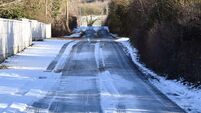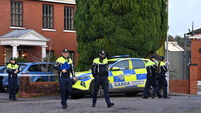An Garda Síochána remains under strength despite arrival of new recruits

Probationer gardaí passing out at last week's graduation ceremony at the Garda College, Templemore. Picture: Colin Keegan/Collins
An Garda Síochána is struggling to increase its workforce despite batches of new recruits, with the latest figures indicating another drop in overall strength.
Numbers at the end of May stood at 13,982, less than at the end of December.
This is despite 166 new recruits leaving Templemore Garda College and joining the force last March.
The organisation is continuing to find it difficult to pull away from the 14,000 mark and towards the target of 15,000 members first set in July 2016 by the then Government. It was supposed to have been achieved by the end of 2021.
Estimates provided by the Government, the Policing Authority, and Garda HQ say there would be at least 1,000 more gardaí were it not for the recruitment restrictions imposed during the peak covid years of 2020 and 2021.
A second batch of recruits, totalling 157 gardaí, entered the force at the end of last month, pushing the figure past 14,000.
The Government has set a target of 800-1,000 recruits during 2024, in five batches of around 200 each.
The Garda strength has been falling since March 2020, when it stood at 14,750.
The Garda Commissioner’s latest monthly report shows that 105 members have retired by the end of May and that a further 72 have resigned. This compares to 150 retirements and 59 resignations in the same period last year.
There have been 72 applications already this year from gardaí looking to extend their service beyond the retirement age, 55 of which have been approved.
It compares to 62 applications for the whole of 2023 and 25 in 2022.
Last March, Justice Minister Helen McEntee announced the retirement age would increase from 60 to 62.
The report also continues to show a high use of overtime, with €28.7m spent in May alone and €89m to date this year — some €24.5m over budget.
Figures show that in relation to 92 gardaí currently suspended as a result of criminal investigations being carried out by the organisation or GSOC, 12 were in relation to sexual assault or sexual misconduct.
A further eight were in relation to domestic violence/coercive control, five were in relation to assault, and a further five were in connection with drugs.
Eight were related to corruption or criminal association.
The report said there were 924 incidents where garda force was used in May, similar to April.
It said 16 civilians and 15 gardaí were injured in May, compared to 22 civilians and 13 gardaí in April.
Alcohol was involved in 485 of the incidents in May, with drugs involved in 234 cases.
The report details a case on May 26, where gardaí on mobile patrol were waved down by a family whose car had suffered a puncture.
The family were bringing their child to hospital, as they had suffered life-threatening injuries to their arm and were losing significant amounts of blood.
“One member borrowed a jacket and trouser belt to make a tourniquet around the injured arm and successfully stemmed the heavy bleeding, whilst the other member performed traffic duty. Gardaí then transported the child to hospital, where a medical team met them immediately.
“The injured child received the necessary treatment and will make a full recovery.”
Separately, on May 15, the Garda Air Support Unit conducted an extensive search of a rural area for a high-risk missing person, who they located lying at the side of a bog. The missing person was brought to safety.










